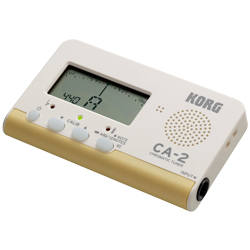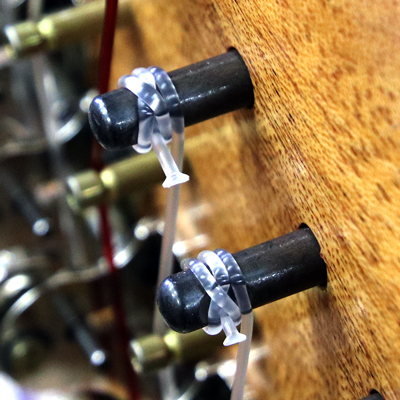Musicmakers Blog
Lever Harp Care: Care and Feeding of your Harp
Learn the basics of how to care for your harp.
Topics covered include tuning, replacing strings, slipping tuning pins, troubleshooting buzzing strings, cleaning, touching up the finish, and minor repairs.
Tuning a Lever Harp

If you don't already have one, we recommend picking up an electronic tuner. It is best to tune the harp with all sharping levers flipped down (disengaged), so there will be no interference from the levers. Please note that this means you may be tuning some strings to flats instead of natural notes. If you have levers on the B strings, for example, you should tune those strings to B-flat when the lever is flipped down. You will then flip these levers up when playing in the key of C.
Most lever harps will have one of three styles of tuning pins - TAPERED HARP PINS, THREADED HARP PINS, OR ZITHER PINS. Both the TAPERED and THREADED Harp Pins go all the way through the neck of the harp and are black in color. The ZITHER Pins do not go all the way through the neck and are silver in color. Note that the THREADED TUNING PINS and the ZITHER PINS drive themselves a little deeper as you turn them clockwise to tighten the strings. If you find that they go deeper than you want, you can turn them counter-clockwise to raise the square ends back to a normal level. When you change strings in the future, you should turn these pins 3-4 complete revolutions counter-clockwise before installing the new strings.
Replacing Strings on a Lever Harp

In reality, harp strings never HAVE to be replaced unless they break. That is not to say that you shouldn't replace your strings - just that you don't have to. If you only play the harp at home for your own enjoyment and you like the sound of your harp, then you don't need to replace the strings. It is that simple. That being said - strings do lose life and vibrancy over time. The common thought is that strings are more or less "dead" after 2 years. Many professional harpists will replace their strings every 6-12 months. To find replacement strings for your Musicmakers harp, refer to our replacement string guide. If you need strings for a harp that was not made by Musicmakers, check out this page.
Learn how to replace strings on your harp.
Slipping Tuning Pins on Lever Harps
If you have THREADED HARP PINS or ZITHER PINS and the pins are slipping then the hole has become worn. There are a couple of ways to fix this. You can remove the pin and take a small amount of super glue or wood glue and carefully spread it around the inside of the hole with a toothpick. Allow this to dry overnight and reinstall the pins. Musicmakers also sells Zither Pins that are slightly larger in diameter. These provide an excellent solution for loose zither pins. Unfortunately, we don't have slightly larger threaded harp pins at this time.
If you have TAPERED HARP PINS and they are slipping then you simply need to push them deeper into the hole as you are tuning. Get someone with some serious muscle if you are unable to push them in hard enough your self. Do not hit them with a hammer. The tuning pin will just bounce back against the wood and you risk doing more damage than good.
Buzzing Harp Strings
Your lever harp need not suffer the problem of rattling or buzzing sounds when you play. If you hear such noises, you can correct them. Here are some troubleshooting hints:
If the buzzing sound occurs only when the SHARPING LEVER is flipped up (engaged), then you need to tighten the LEVER more firmly against the NECK of the harp.
If the buzzing occurs when the LEVER is flipped down (disengaged), the string may be vibrating against some part of the SHARPING LEVER itself. If you have Loveland brand levers, look very closely at the position of the string as it passes through the LEVER bracket. It may be rattling against the plastic cam (the part that you flip up & down), or against the small "fretpost" (the part that the cam pinches the string against when engaged.) You can change the position of the string by raising or lowering the BRIDGE PIN on which the string rests above the SHARPING LEVER. (Make sure the string is resting in the groove of that PIN.) If you have threaded bridge pins, it is a simple matter of twisting the bridge pin in or out, watching how that moves the string in relation to the SHARPING LEVER. If you don't have threaded bridge pins you can push the Guide pin in by placing the end of a bolt on the pin and gently tapping the bolt with a hammer. To pull the bridge pin out you can use some pliers. Just put some leather or tape over the teeth of the pliers so you don't damage the bridge pins.
If the problem is not located around the SHARPING LEVER, you may have a loose end of string that is rattling inside the sound chamber. Put your hand inside the harp and touch the knotted ends while plucking the harp to see where the problem is located. Oftentimes you can solve it by simply trimming off a loose end of string or by twisting the knotted end in a different direction.
Cleaning Your Lever Harp

We recommend Old English polish because it does not contain any silicone or wax—both of which would cause problems should you ever need to re-finish or touch up the finish of your harp.
Touching up Finish on Lever Harp
Simple scratches will usually disappear with an application of Old English. If the scratch is a deeper you might try some touch up graining pens available at most local hardware stores. Any repair beyond this is somewhat beyond the scope of this article.
Repairing Your Lever Harp
If you ever need to repair the wood parts of your lever harp, you will be glad to know that the NECK/PILLAR assembly can be removed from the sound chamber to facilitate repair work. Simply loosen the strings and unhook them from the TUNING PINS. Then remove any screws from the BASE of the harp to allow the NECK/PILLAR to come free of the harp body.
Considering purchasing a lever harp? Musicmakers builds a variety of lever harps to accommodate all harpists from beginner to professional. Our harp selection serves a variety of needs: travel, music therapy, and concert halls. We have something just for you.
